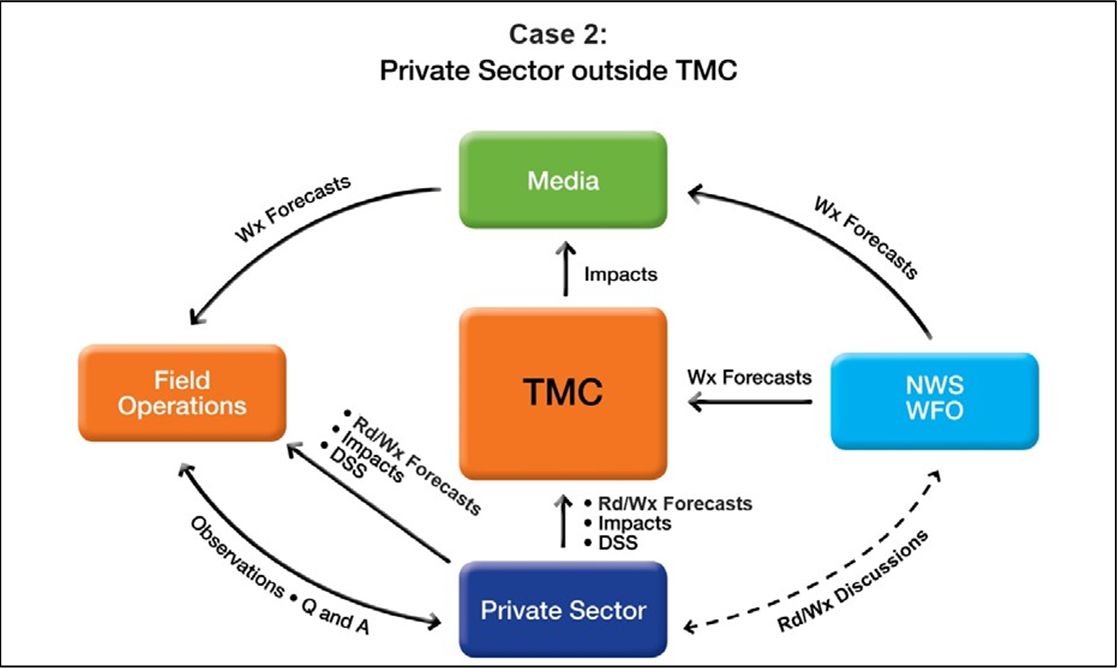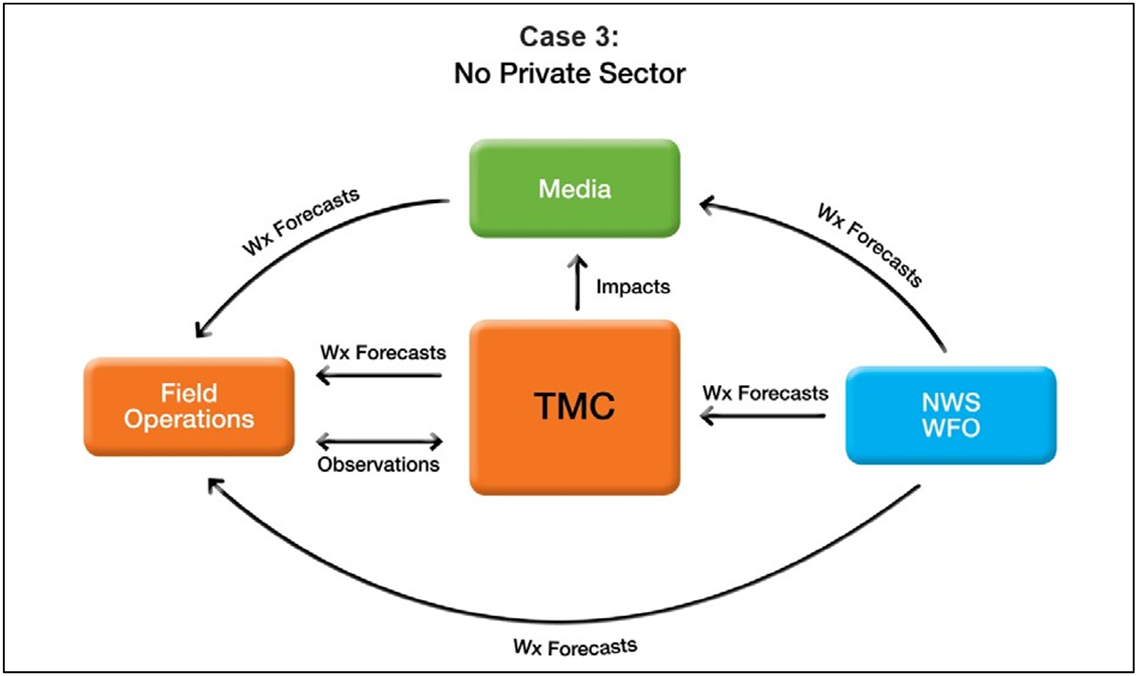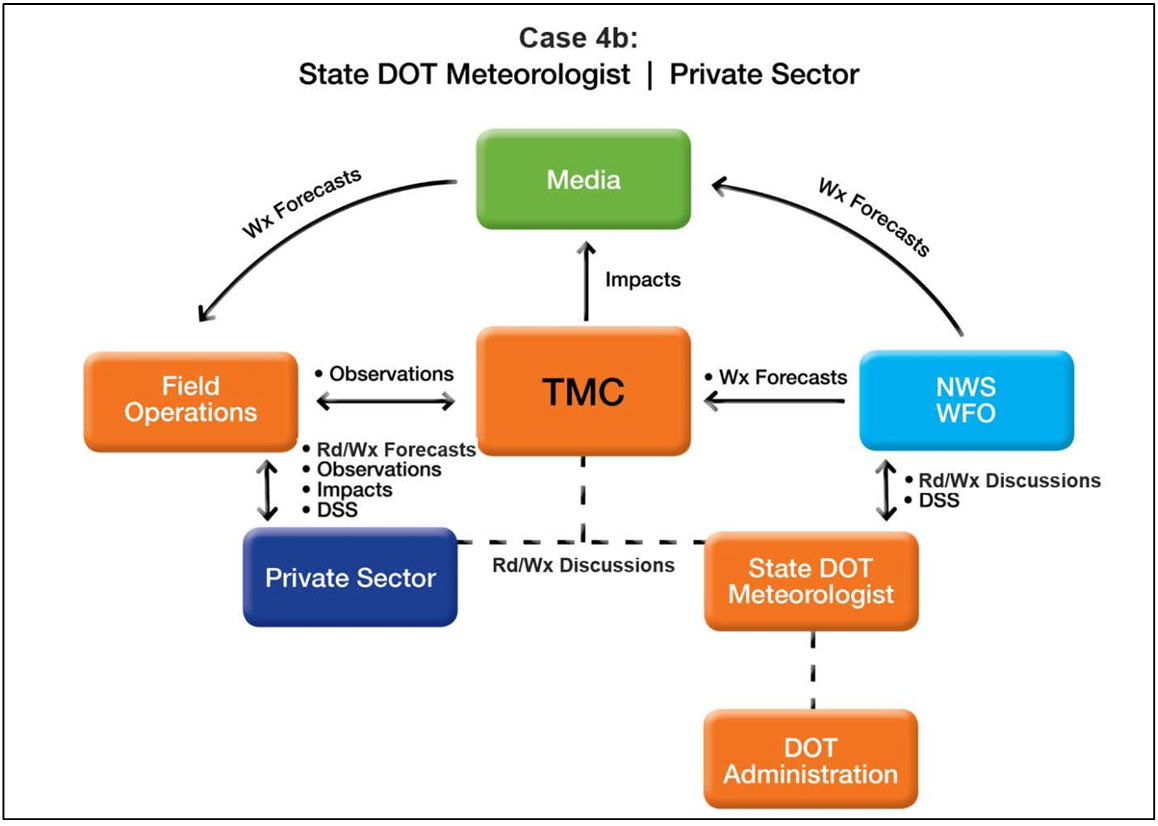Collaboration Across the Road Weather Enterprise: The Pathfinder Project
APPENDIX G. PARTNER COLLABORATION AND RELATIONSHIPS
As mentioned in the body of the report, every State Department of Transportation (DOT) has a different operational configuration with their private sector contractor, and some DOTs do not have one. The operational configuration of the partners will affect how communication and collaboration takes place. Five configuration cases were identified nationwide. They are:
- Case 1 - Private Sector Meteorologist in the Traffic Management Center (TMC).
- Case 2 - Private Sector Meteorologist outside the TMC.
- Case 3 - No Private Sector Meteorologist.
- Case 4a - Private Sector and DOT Meteorologists in the TMC.
- Case 4b - Private Sector and DOT Meteorologists outside the TMC.
For Cases 1, 2 and 3, there is no DOT-employed meteorologist on staff. In Case 4, the DOT has an employed meteorologist. The physical location of the meteorologists during events affects communication among all the players. Therefore, Cases 1, 2, 4a and 4b specify the physical location of the meteorologists inside or outside of the TMC. There was no configuration found nationwide in which a DOT has an employed meteorologist but no private sector. The schematics in Figures 23-27 illustrate the five possible DOT-private configurations and how event-specific communication would flow between all participants in an idealized manner. Media is included as an important part of the weather enterprise and is an important conduit for traveler information (TI) and forecasts.
Note: "Wx" = weather; "Rd/Wx" = road weather or road and weather, and "DSS" = decision support systems.

Figure 23. Chart. Schematic of Idealized, Event-specific Communication Flow for Case 1.
(Source: Federal Highway Administration)

Figure 24. Chart. Schematic of Idealized, Event-specific Communication Flow for Case 2.
(Source: Federal Highway Administration)

Figure 25. Chart. Schematic of Idealized, Event-specific Communication Flow for Case 3.
(Source: Federal Highway Administration)

Figure 26. Chart. Schematic of Idealized, Event-specific Communication Flow for Case 4a.
(Source: Federal Highway Administration)

Figure 27. Chart. Schematic of Idealized, Event-specific Communication Flow for Case 4b.
(Source: Federal Highway Administration)
Successful collaborative partnerships arise from building relationships between all participants within the DOT and weather enterprise. Relationships should be fostered through successive and varied joint activities throughout the year, and at different timescales: seasonal, event-centric and ongoing. It is important that each mode of interaction becomes part of standard operating procedures. Interaction methodologies should be clearly outlined and practiced regularly. While partner interaction may become a requirement in operational policy, authentic trust, open dialogue and true collaboration are built over time and by working toward a common goal. Each partner must be willing not only to give information, but also to listen and to consider the viewpoint from the other agency. Ultimately, the purpose of the collaboration is to provide the traveling public with consistent road weather impact information so they can make better decisions, and this goal must be kept central to the effort.
In many ways, this effort is about changing or enhancing operational culture at the DOT, in the private sector, and at the NWS. For example, meteorologists from one organization collaborating with those from another is certainly contrary both to operational meteorologist training and to the goals of the individual weather company or agency, whose business model is the creation of a proprietary forecast product. As witnessed in Utah, it took a complete change of culture to have the meteorologists let down their guards and come to the table to listen and share openly. In Utah, forecast disagreements between the Salt Lake City WFO and UDOT's private sector meteorologist were rare. However, the leadership in the WFO recognized that when disagreements did arise, it was best practice for their forecasters to leverage and integrate the expertise of the DOT's meteorologists in forecasting road weather parameters, especially for rural areas in the State. Meteorologists on both sides needed to be reminded each time that the ultimate goal of the collaboration goes beyond having the "best" weather forecast, to having a shared impact message so the public can take appropriate action. At the same time, DOT management must realize that putting forth the effort to collaborate pays off on the transportation system and the efficiency of their operations.